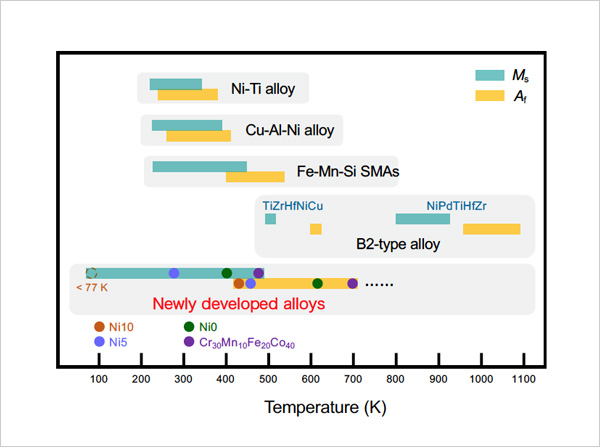Development of High Entropy Alloys Exhibiting Shape Memory Effect
2019.10.16
National Institute for Materials Science (NIMS)
NIMS and Seoul National University have jointly developed high entropy alloys capable of exhibiting a shape memory effect (SME). These alloys exhibit SME across a wider temperature range than existing shape memory alloys and at higher temperatures than nickel-titanium alloys. High entropy alloys with these properties may be applicable to the development of high-temperature actuators and other equipment.
Abstract
- NIMS and Seoul National University have jointly developed high entropy alloys capable of exhibiting a shape memory effect (SME). These alloys exhibit SME across a wider temperature range than existing shape memory alloys and at higher temperatures than nickel-titanium alloys. High entropy alloys with these properties may be applicable to the development of high-temperature actuators and other equipment.
- The term “high entropy alloy” refers to a solid solution alloy composed of equal molar ratios of five or more chemical elements and alloys similar in composition. These alloys have been researched intensively worldwide in recent years and national projects on this subject are underway in Europe, the United States, South Korea, Taiwan and other countries. Japan has also launched a related project entitled, “High entropy alloys: science of new class of materials based on elemental multiplicity and heterogeneity,” funded by the MEXT Grant-in-Aid for Scientific Research on Innovative Areas. Most conventional alloys are composed of one primary chemical element and trace amounts of additional elements, whereas high entropy alloys are composed of high concentrations of multiple elements. Research on the rarely studied compositional variations of high entropy alloys may lead to the discovery of materials with novel properties and functions.
- The Cantor alloy is a type of FCC (face-centered cubic) alloy composed of equal ratios (20%) of Cr, Mn, Fe, Co and Ni. The joint research team recently performed thermodynamic calculations to determine the stability of FCC and HCP (hexagonal close-packed) phases in alloys similar to the Cantor alloy in composition. This study led to the discovery of high entropy alloys with an ability to undergo reversible martensitic transformation between the FCC and HCP phases when subjected to temperature changes. In addition, the group demonstrated that these alloys, after being reshaped, are capable of recovering their original shapes when heated, an indication of SME.
- While the shape recovery temperature ranges of conventional shape memory alloys are limited, those of high entropy alloys can be modified flexibly by changing their compositions.
- In future research, we plan to investigate the effect of heat treatments and microstructures on SME and hope to further enhance the properties of these alloys for use in pipe joints, high-temperature actuators and other applications.
- This project was carried out by a research team led by Jein Lee (Researcher, International Center for Young Scientists (ICYS), NIMS; currently an Assistant Professor at the Pusan National University), Koichi Tsuchiya (ICYS Managing Director, NIMS; also the Leader of the Corrosion Resistant Alloy Group, Research Center for Structural Materials, NIMS) and Eun Soo Park (Professor, Seoul National University).
This research project was conducted as part of another project entitled “High entropy alloys: science of new class of materials based on elemental multiplicity and heterogeneity” funded by the MEXT Grant-in-Aid for Scientific Research on Innovative Areas. - This research was published in Scientific Reports, an open access journal, on September 11, 2019.

figure: Comparison of martensitic transformation temperatures of the newly developed high entropy alloys and existing shape memory alloys. Ms: the temperature at which martensitic transformation starts. Af: temperature at which reverse martensitic transformation is completed (shape recovery temperature).
Related files
- ICYS
Contacts
(Regarding this research)
-
Koichi Tsuchiya
Managing Director,
International Center for Young Scientists (ICYS)
National Institute for Materials Science (NIMS)
Tel: +81-29-859-2117
E-Mail: tsuchiya.koich=nims.go.jp
(Please change "=" to "@")
(General information)
-
Public Relations Office
National Institute for Materials Sciences
Tel: +81-29-859-2026
Fax: +81-29-859-2017
E-Mail: pressrelease=ml.nims.go.jp
(Please change "=" to "@")
(Regarding the MEXT-funded high entropy alloy project)
-
Haruyuki Inui
(Area Organizer for the project “High entropy alloys: science of new class of materials based on elemental multiplicity and heterogeneity” funded by the MEXT Grant-in-Aid for Scientific Research on Innovative Areas)
Professor
Department of Materials Science and Engineering
Kyoto University
Tel: +81-75-753-5467
E-Mail: inui.haruyuki.3z=kyoto-u.ac.jp
(Please change "=" to "@")
Same Keywords
-
Automated High-Throughput System Developed to Generate Structural Materials Databases
(alloy)
2025.07.07
-
Increasing High-Temperature Strength of Materials Through Collaborative Efforts of AI and Materials Researchers
(alloy)
2023.09.25
-
Highly Fatigue-Resistant FMS Alloy with Enhanced Weldability
(alloy)
2021.03.10
